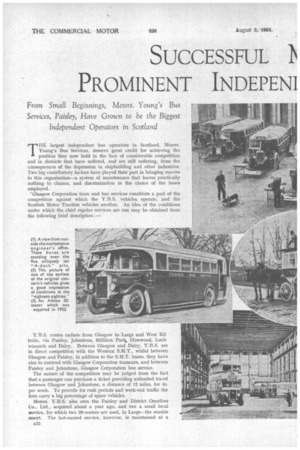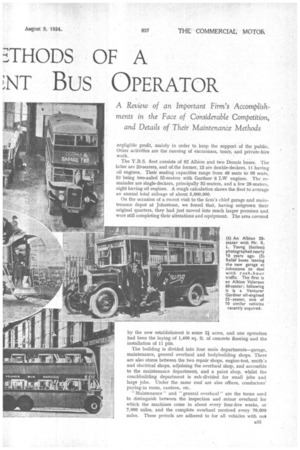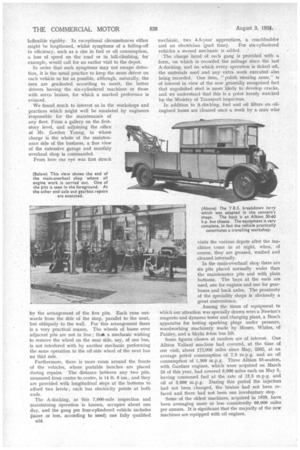SUCCESSFUL l■ - 3THODS OF A
Page 44

Page 45

Page 46

If you've noticed an error in this article please click here to report it so we can fix it.
PROMINENT INDEPENI
NT Bus OPERATOR THE largest independent bus operators in Scotland, Messrs. Young's Bus Services, deserve great credit for achieving the position they now hold in the face of considerable competition and in districts that have suffered, and are still suffering, from the consequences of the depression in shipbuilding and other industries. Two big contributory factors ha,ve played their part in bringing success to this organization—a system of maintenance that leaves practically nothing to chance, and discrimination in the choice of the buses employed.
'Glasgow Corporation tram and bus services constitute a part of the competition against which the Y.B.S. vehicles operate, and the Scottish Motor Traction vehicles another. An idea of the conditions under which the chief regular services are run may be obtained from the following brief description :— Y.B.S. routes radiate from Glasgow to Largs and West Kil bride, via Paisley, Johnstone, Milliken Park„, Howwood, Loch. winnoch and Dairy. Between Glasgow and Dairy, Y.B.S. are in direct competition with the Western S.M.T., whilst between Glasgow and Paisley, in addition to the S.M.T. buses, they have also to contend with Glasgow Corporation tramcars, and between Paisley and Johnstone, Glasgow Corporation bus service.
The nature of the competition may be judged from the fact that a passenger can purchase a ticket providing unlimited travel between Glasgow and Johnstone, a distance of 12 miles, for 4s. per week. To provide for rush periods and week-end traffic the firm carry a big percentage of spare vehicles.
Messrs. Y.B.S. also own the Paisley • and District Omnibus Co., Ltd., acquired about a year ago, and run a small local service, for which two 20-seaters are used, in Largs—the seaside resort. The last-named service, however, is maintained at a B32 negligible profit, mainly in order to keep the support of the public. Other activities are the running of excursions, tours, and private-hire work.
The Y.B.S. fleet consists of 82 Albion and two Dennis buses. The latter are 20-seaters, arid oLthe former, 13 are double-deckers, 11 having oil engines. Their seating capacities range from 48 seats to 60 seats, 10 being two-axled 55-seaters with Gardner• 6 LW engines. The remainder are single-deckers, principally 32-seaters, and a few 28-seaters, eight having oil engines. A rough calculation shows the fleet to average an annual total mileage of about 5,000,000.
On the occasion of a recent visit to the firm's chief garage and maintenance depot at Johnstone, we found that, having outgrown their original quarters, they had just moved into much larger premises and were still completing their alterations and equipment. The area covered by the new establishment is some 2i acres, and one operation had been the laying.of 1,400 sq. ft. of concrete flooring and the installation of 11 pits.
The building is divided into four main departments—garage, maintenance, general overhaul and bodybuilding shops. There are also stores between the two repair shops, engine-test, smith's and electrical shops, adjoining the overhaul shop, and accessible to the maintenance department and a paint shop, whilst the coachbuilding department is sub-divided for small jobs and large jobs. Under the same roof are also offices, conductors' paying-in room, canteen, etc.
" Maintenance " and "general overhaul" are the terms used to distinguish between the inspection and minor overhaul for which the machines come in about every four-five weeks, or 7,000 miles, and the complete overhaul received every 70,000 miles. These periods are adhered to for all vehicles with not inflexible rigidity. In exceptional circumstances either might be lengthened, whilst symptoms of a falling-off in efficiency, such as a rise in fuel or oil consumption, a loss of speed on the road or in hill-climbing, for example, would call for an earlier visit to the depot.
In order that such symptoms may not escape detection, it is the usual practice to keep the same driver on each vehicle so far as possible, although, naturally, the men are graduated according to merit, the better drivers having the six-cylindered machines or those with servo brakes, for which a marked preference is evinced.
We found much to interest us in the workshops and practices which might well be emulated by engineers responsible for the maintenanCe of any fleet. From a gallery on the firststory level, and adjoining the office of Mr. Gordon Young, in whose charge is the whole of the maintenance side of the business, a fine view of the extensive garage and monthly overhaul shop is commanded.
From here our eye was first struck by the arrangement of the five pits. Each runs outwards from the side of the shop, parallel to the next, but obliquely to the wall. For this arrangement there is a very practical reason. The wheels of buses over adjacent pits are not in line ; this a mechanic wishing to remove the wheel on the near side, say, of one bus, is not interfered with by another mechanic performing the same operation to the off-side wheel of the next bus on teat side.
Furthermore, there is more room around the fronts of the vehicles, where portable benches are placed during repairs. The distance betWeen any two pits, measured from centre to centre, is 14 ft. 6 ins., and they are provided with longitudinal steps at the bottoms to afford two levels ; each has electricity points at both ends.
The A-docking, as this 7,000-mile inspection and maintaining operation is known, occupies about one day, and the gang per four-cylindered vehicle includes (more or less, according to need) one fully qualified
B34 mechanic, two 4-5-year apprentices, a coachbuilder and an electrician (part time). For six-cylindered vehicles a second mechanic is added.
The charge hand of each gang is provided with a form, on which is recorded the mileage since the last A-docking, and on which every operation is ticked off, the materials used and any extra work executed also being recorded. One item, "polish steering arms," is of interest in view of the now generally recognized fact that unpolished steel is more likely to develop cracks, and we understand that this is a point keenly watched by the Ministry of Transport inspectors.
In addition to A-docking, fuel and oil filters on oilengined buses are cleaned once a week by a man who visits the various depots after the machines come in at night, when, of course, they are greased, washed and cleaned internally.
In the main-overhaul shop there are six pits placed normally wider than the maintenance pits and with plain bottoms. The bays at the ends are used, one for engines and one for gearboxes and back axles. The proximity of the speciality shops is obviously a great convenience.
Among the items of equipment to which our attention was specially drawn were a Newton's magneto and dynamo tester and charging plant, a Bosch apparatus for testing sparking plugs under pressure, woodworking machinery made by Messrs. Whites, of Paisley, and a Skyhi 8-ton bus lift.
Some figures chosen at random are of interest. One Albion Valiant machine had covered, at the time of our visit, about 175,000 miles since May, 1932, at an average petrol consumption of 7.3 m.p.g. and an oil consumption of 1,360 m.p.g. Three Albion 55-seaters, with Gardner engines, which were acquired on March 24 of this year, had covered 9,000 miles each on May 5, having consumed fuel at the rate of 12.5 m.p.g. and oil at 3,000 m.p.g. During this period the injectors had not been changed, the brakes had not been refaced and there had not been one involuntary stop.
Some of the oldest machines, acquired in 1928, have been averaging more or less consistently 60,000 miles per annum. It is significant that the majority of the new machines are equipped with oil engines.






















































































